"BEST OF US" PHOTO SHARING VIDEO PROJECT
In June we invited our members to send us their favorite bird photos from the past year to be part of our annual “Best of Us” Photo Sharing Video Project, and wow, they did not disappoint! Most of the photos submitted were taken locally right here in Northeast Florida, as fewer folks were traveling due to the pandemic. But the fabulous pics from our neck of the woods just go to show the amazing beauty and diversity of bird species we have here. We are lucky to have so many different habitats and ecosystems easily accessible, not only for us bird lovers, but also for the birds themselves.
From contributors who were able to travel last year, there are also some wonderful species that we don’t get to see in our area. Here are a few of the fantastic photos you’ll see in the video:
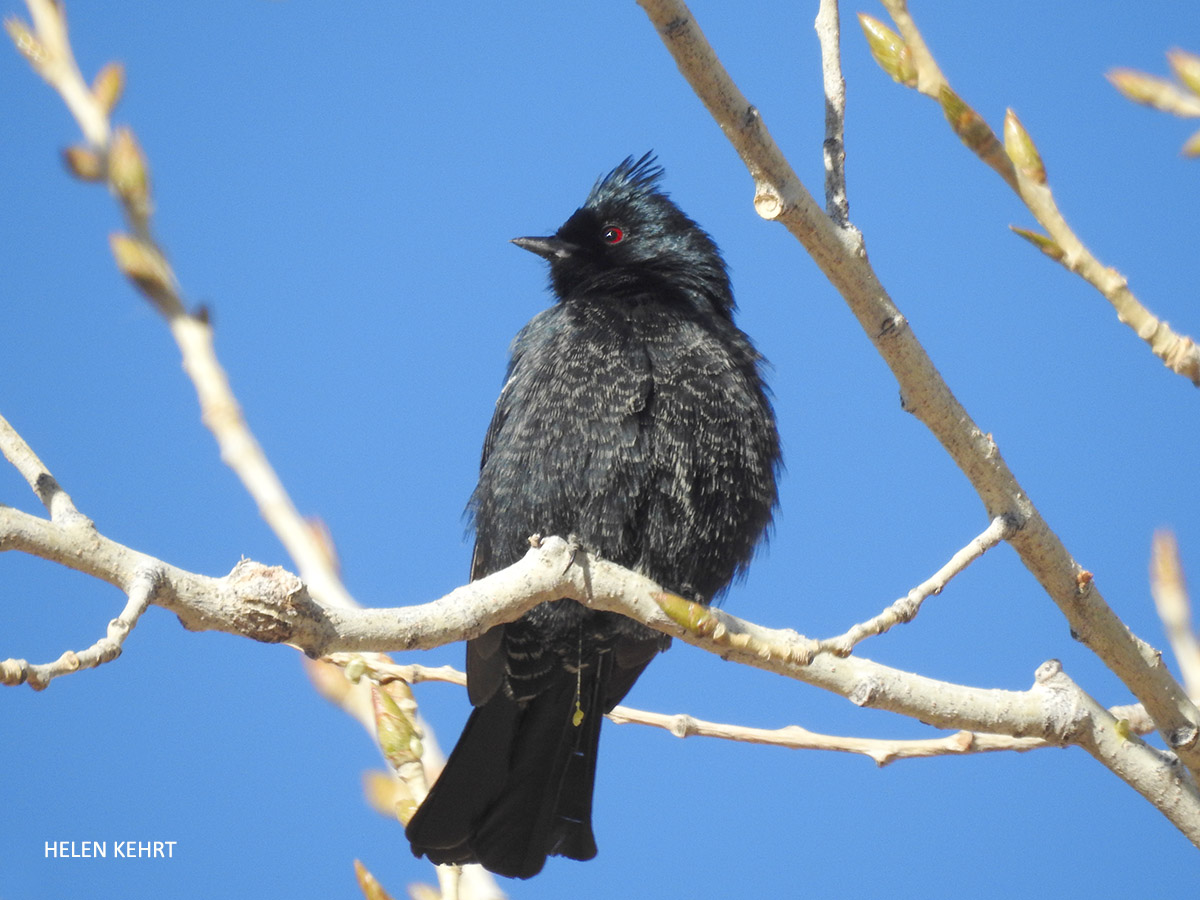
Helen Kehrt’s photo of a Phainopepla from her travels in Arizona shows the glossy jet-black plumage of this fascinating species – looks sort of like an all-black Northern Cardinal, don’t you think?

Jay Kauffman captured this lovely Snowy Egret at the Lakewood Wader Rookery in Jacksonville last October. He says this bird is there nearly every day.
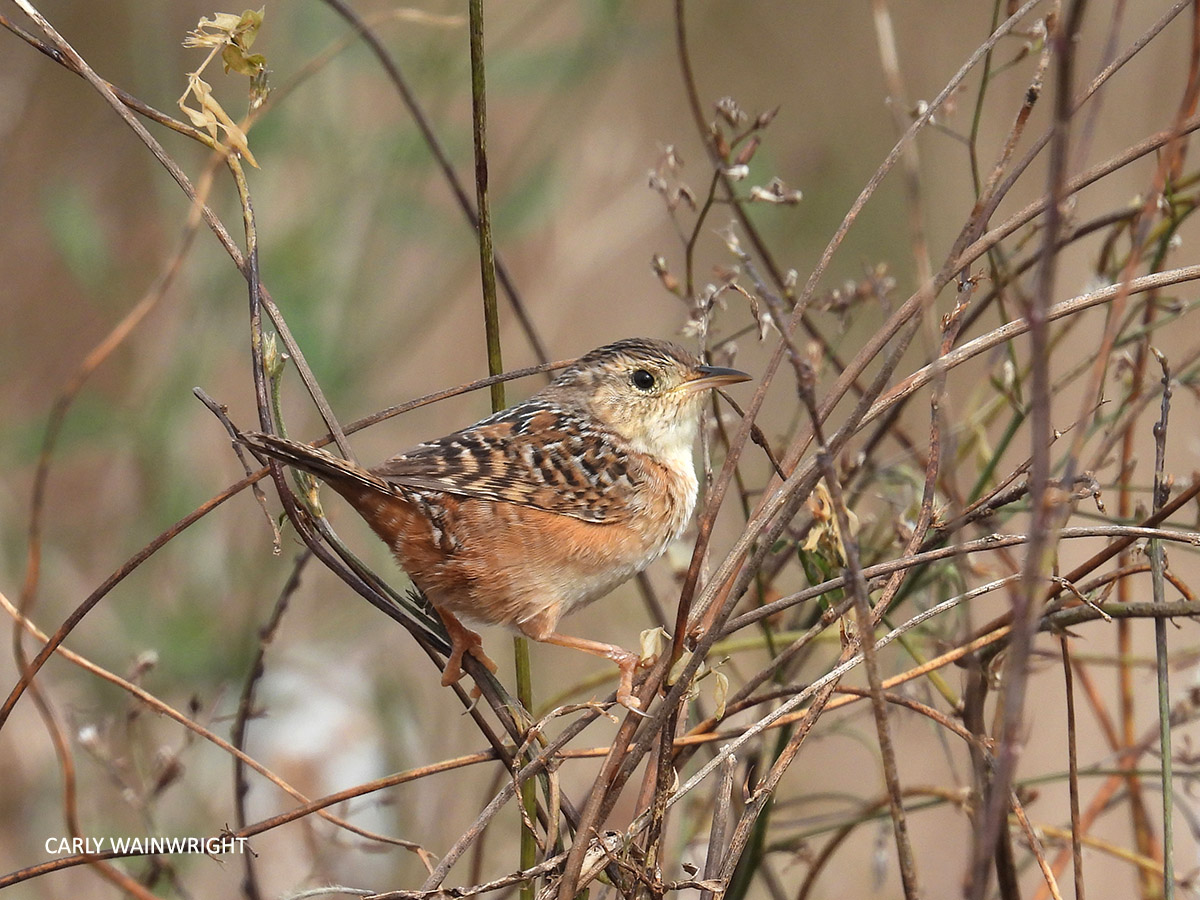
Carly Wainwright’s lovely shot of a Sedge Wren was captured at Jacksonville's Westside Industrial Park last December. This species is fairly rare and is far more commonly heard than seen, so it was quite a feat to get such a great photo of this beautiful little bird.
Check out the entire video on our YouTube channel to see all the photos, and many thanks to the contributors for letting us highlight your gorgeous photography! Photographers, get out and get those bird photos for next year’s video!
~ Carol Bailey-White, President
LIGHTS OUT NORTHEAST FLORIDA UPDATE
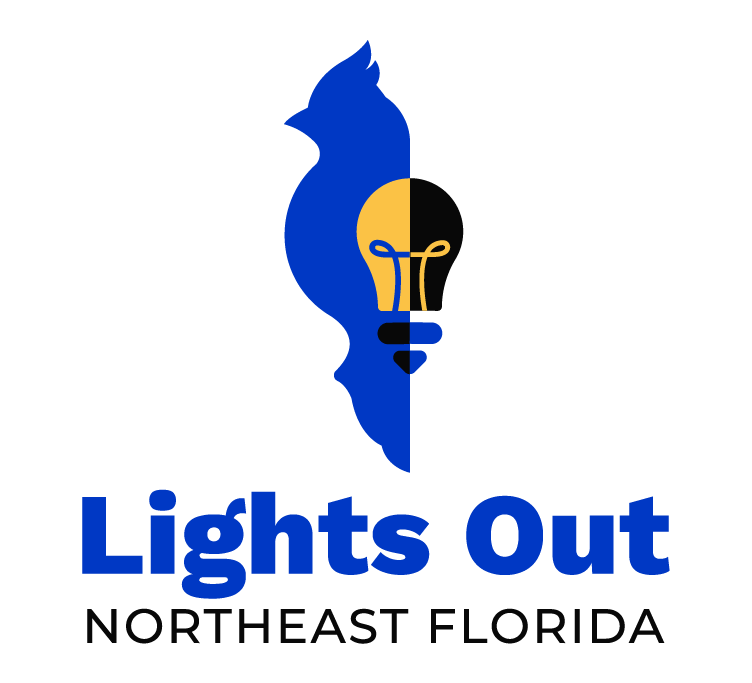 Lights Out Northeast Florida (LONF), a partnership of Duval Audubon Society, St. Johns County Audubon Society, and the Jacksonville Zoo and Gardens, has been doing crucial citizen science this year. While eBird records bird sightings in a particular area and can be used to determine approximately how many and what kind of birds there are in an area at any given time, LONF has been documenting the hazards to migrating birds created by the downtown Jacksonville area; in particular, the lighting of downtown buildings at night and the trouble they cause to nocturnal migrators. It is well known that many species migrate at night, using the night sky to navigate, and that lighting in metropolitan areas causes problems for the birds. A major migration route of the Atlantic Flyway runs right through Jacksonville. Until this spring, no one has tried to determine what issues our well-lit downtown creates for these birds. Lights Out Northeast Florida (LONF), a partnership of Duval Audubon Society, St. Johns County Audubon Society, and the Jacksonville Zoo and Gardens, has been doing crucial citizen science this year. While eBird records bird sightings in a particular area and can be used to determine approximately how many and what kind of birds there are in an area at any given time, LONF has been documenting the hazards to migrating birds created by the downtown Jacksonville area; in particular, the lighting of downtown buildings at night and the trouble they cause to nocturnal migrators. It is well known that many species migrate at night, using the night sky to navigate, and that lighting in metropolitan areas causes problems for the birds. A major migration route of the Atlantic Flyway runs right through Jacksonville. Until this spring, no one has tried to determine what issues our well-lit downtown creates for these birds.
Twenty-six dedicated volunteers took to the streets of downtown Jacksonville every week from March 16 until May 29 covering four predetermined routes and looking for dead or injured migrating birds that had struck a building. The four routes were walked a total of 129 times. In addition, the Downtown Ambassadors, who walk the downtown streets every morning to help clean and maintain the downtown area, assisted by collecting and reporting any dead or injured birds they found. Volunteers collected the birds, recording the exact location and species of each and assisting stunned birds.
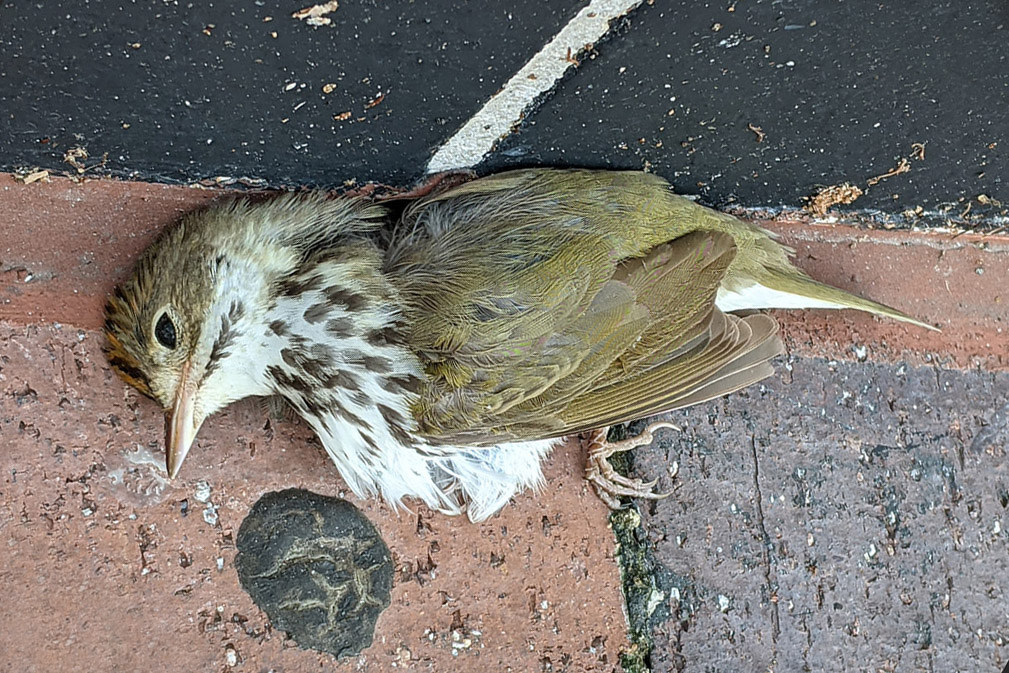 In summary, the volunteers found 101 birds that had struck buildings; 71 were dead and 30 were stunned. Most of the stunned birds recovered and were taken to points north of town so that they would not have to pass through downtown again! Ovenbirds were by far the most common species to collide with buildings downtown; however, various species of warblers were found as well as an Indigo Bunting, a Chuck-will’s-widow, and a Yellow-bellied Sapsucker, to name a few. In summary, the volunteers found 101 birds that had struck buildings; 71 were dead and 30 were stunned. Most of the stunned birds recovered and were taken to points north of town so that they would not have to pass through downtown again! Ovenbirds were by far the most common species to collide with buildings downtown; however, various species of warblers were found as well as an Indigo Bunting, a Chuck-will’s-widow, and a Yellow-bellied Sapsucker, to name a few.
While this is not complete data – the routes were only walked 3-4 times a week and there are areas that were not covered at all – it does give us an idea of the extent of the problem and which parts of which buildings are the worst culprits.
You can learn much more about the Lights Out Northeast Florida initiative by watching this excellent video, created in partnership with the UNF Institute of Environmental Research and Education by student Ryan Nugent.
LONF has only begun to collect data. We believe that fall migration may be worse with all the juvenile birds that will be migrating for the first time. We will hit the streets again starting September 15. Be a part of this ground-breaking project and volunteer to help one morning a week for two months. You will be trained and all your supplies (except a cell phone) will be provided. Please complete our online application, and we will be in touch soon. Thank you!
~ Carolyn Antman, Conservation Director for Duval County
INVASIVE PLANT CONTROL AT CROSBY SANCTUARY
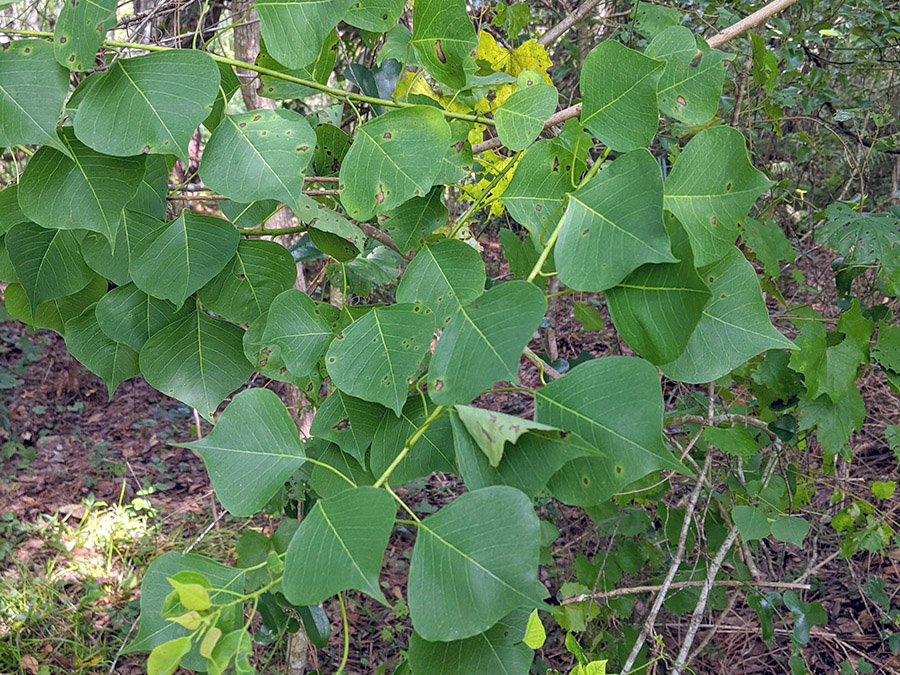 Last weekend a small crew worked at Crosby Sanctuary to remove invasive plants that had grown up over the past few years. We haven’t done much work on invasive plants in a while, so they have come back more than expected. The main offenders were camphor tree and Chinese tallow tree, but there was plenty of Japanese climbing fern and air potato to go around. We also controlled some Mexican petunia and Johnsongrass along the ditch. Wild taro is also very abundant in the ditch and downstream wetland, but we didn’t have the time or energy to deal with them that day. Do any of these invasive plants sound familiar? They are all very common in our natural and urban/suburban areas of northeast Florida. Last weekend a small crew worked at Crosby Sanctuary to remove invasive plants that had grown up over the past few years. We haven’t done much work on invasive plants in a while, so they have come back more than expected. The main offenders were camphor tree and Chinese tallow tree, but there was plenty of Japanese climbing fern and air potato to go around. We also controlled some Mexican petunia and Johnsongrass along the ditch. Wild taro is also very abundant in the ditch and downstream wetland, but we didn’t have the time or energy to deal with them that day. Do any of these invasive plants sound familiar? They are all very common in our natural and urban/suburban areas of northeast Florida.
The Ixia Chapter of the Florida Native Plant Society initiated the workday, so props to them for helping motivate us to deal with our invasive plants. A special thanks to Ixia Vice President Adam Arendell for coming out to help!
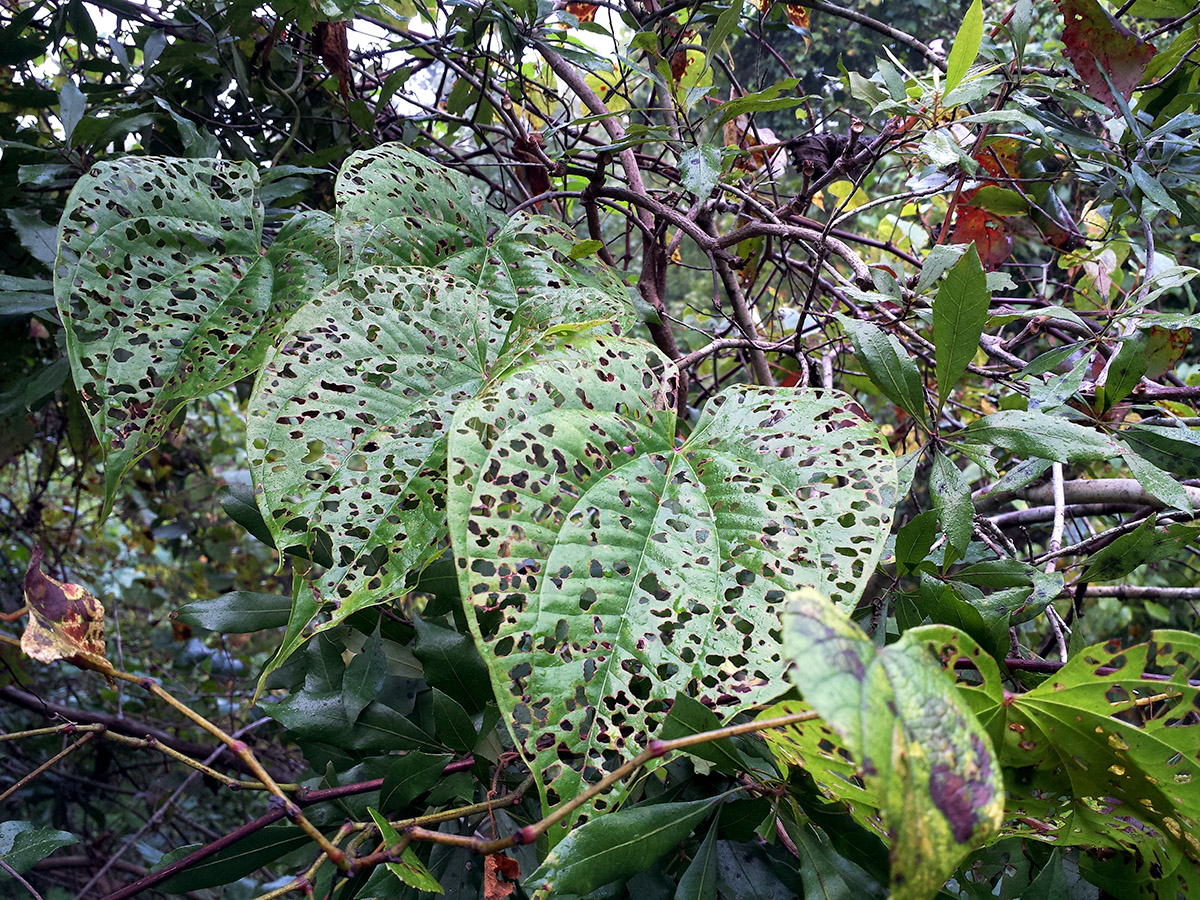 How were these highly invasive plants removed, you might ask? Well, if you read the guidance from IFAS or other sources, then you will hear the term Integrated Pest Management approach. This involves careful planning and implementation of multiple methods over time to manage invasive plants. The methods include prevention, biocontrol, mechanical removal, chemical control and anthropomorphic manipulation by fire, flood, drawdown, etc. The two methods currently being implemented at Crosby include biocontrol and chemical control, as well as maybe a bit of prevention. Air potato beetles were a biocontrol introduced in Clay and Duval counties about ten years ago and their larvae have been seen at Crosby feeding on air potato leaves. They are partially effective at keeping the air potato in check, but not completely wiping it out. The larvae need something to eat and air potato is all they eat. How were these highly invasive plants removed, you might ask? Well, if you read the guidance from IFAS or other sources, then you will hear the term Integrated Pest Management approach. This involves careful planning and implementation of multiple methods over time to manage invasive plants. The methods include prevention, biocontrol, mechanical removal, chemical control and anthropomorphic manipulation by fire, flood, drawdown, etc. The two methods currently being implemented at Crosby include biocontrol and chemical control, as well as maybe a bit of prevention. Air potato beetles were a biocontrol introduced in Clay and Duval counties about ten years ago and their larvae have been seen at Crosby feeding on air potato leaves. They are partially effective at keeping the air potato in check, but not completely wiping it out. The larvae need something to eat and air potato is all they eat.
 The other control method was chemical control by careful application of herbicides to the target invasive plants only. Two herbicides were applied using frill and girdle, cut stump and foliar applications (spraying leaves). Garlon 3a herbicide was applied to woody trees such as camphor and tallow in a girdle cut at the base of the tree (larger trees) and to cut stumps (smaller trees). Rodeo herbicide was applied by foliar application to herbaceous species such as Japanese climbing fern, air potato, and Johnsongrass. Some may question the use of herbicides, but they are absolutely necessary in the fight against invasive species. That said, common sense tells you not to overdo it with the herbicide. When used sparingly and targeted to the invasive plants only, then herbicides can be used effectively and safely within natural areas and preserves. It’s when they are applied in excess or over too large an area at one time, such as farms or aquatic weed infestation areas, that they can become a real problem. The other control method was chemical control by careful application of herbicides to the target invasive plants only. Two herbicides were applied using frill and girdle, cut stump and foliar applications (spraying leaves). Garlon 3a herbicide was applied to woody trees such as camphor and tallow in a girdle cut at the base of the tree (larger trees) and to cut stumps (smaller trees). Rodeo herbicide was applied by foliar application to herbaceous species such as Japanese climbing fern, air potato, and Johnsongrass. Some may question the use of herbicides, but they are absolutely necessary in the fight against invasive species. That said, common sense tells you not to overdo it with the herbicide. When used sparingly and targeted to the invasive plants only, then herbicides can be used effectively and safely within natural areas and preserves. It’s when they are applied in excess or over too large an area at one time, such as farms or aquatic weed infestation areas, that they can become a real problem.
We have more to do at Crosby with invasive plants, so please come to one of our future workdays to help! We plan to include invasive plant surveys and control at all our workdays in the future, just to better stay on top of them. An ounce of prevention is worth a pound of cure. This is so true with invasive plants. If you can prevent them from getting well established, then it’s far less work to control them than if you wait until they overtake an area.
~ Pete Johnson, Crosby Sanctuary Director
RIVERFRONT PARKS NOW CALL TO ACTION
 Duval Audubon Society is a member of the Riverfront Parks Now (RPN) coalition, a Jacksonville-based organization advocating for City-owned property along the St. Johns River downtown to be developed into riverfront park space with areas of natural wetlands and flood overflow that would also provide natural recreation open to all, encourage people to go downtown, and provide business opportunities as well as flood protection for downtown businesses. We recognize the incredible opportunity now before the Jacksonville community to make the downtown riverfront into a green destination like those in many North American cities. Pittsburgh’s Three Rivers Heritage Trail, Louisville’s Waterfront Park, Cincinnati’s Smale Riverfront Park, and Vancouver’s Stanley Park are all great examples of beautiful and successful parklands connecting the community with their city’s greatest asset – their waterfront. Duval Audubon Society is a member of the Riverfront Parks Now (RPN) coalition, a Jacksonville-based organization advocating for City-owned property along the St. Johns River downtown to be developed into riverfront park space with areas of natural wetlands and flood overflow that would also provide natural recreation open to all, encourage people to go downtown, and provide business opportunities as well as flood protection for downtown businesses. We recognize the incredible opportunity now before the Jacksonville community to make the downtown riverfront into a green destination like those in many North American cities. Pittsburgh’s Three Rivers Heritage Trail, Louisville’s Waterfront Park, Cincinnati’s Smale Riverfront Park, and Vancouver’s Stanley Park are all great examples of beautiful and successful parklands connecting the community with their city’s greatest asset – their waterfront.

Now that a design has been selected for the former Jacksonville Landing site, RPN is focusing attention on Metropolitan Park and the adjacent former Shipyards site. We need your support for the duPont Fund’s Esplanade 1 vision that joins Metropolitan Park and the Shipyards into one cohesive, iconic park. The Esplanade 1 plan is the preliminary result of duPont’s ongoing Riverfront Activation Study. Esplanade 1 establishes RPN’s desired Riverfront for All by applying well thought out social, cultural, and urban planning principles while incorporating suggestions from the initial community engagement. This is not yet a firm park plan as community engagement is still underway, so there are still opportunities for you to get involved to help shape the features and amenities of the space.
We ask that the Downtown Investment Authority, the Mayor, and the City Council align towards this effort as they have aligned on Groundwork Jacksonville’s Emerald Trail. Esplanade 1 would be the perfect destination for the Emerald Trail as connections are planned at Hogans Creek, at Bay Street, at A. Philip Randolph Boulevard, and via the Riverwalk.
If you are a Jacksonville resident, please consider writing to the Downtown Investment Authority (DIA), the Mayor and the City Council and ask them to:
- Support the holistic vision of Esplanade 1 with the goal to legally define and protect the public riverfront property as shown to ensure the connection of Metropolitan Park and the Shipyards (approximately 49 acres);
- Fund our urban riverfront parks, including the Landing, Esplanade 1 and enhanced Riverwalk, at a level that will produce world class park designs and construction over a multi-year period;
- With regard to the Four Seasons/Kids Kampus legislation (coming in August), require Shad Khan's Iguana real estate investment company to strengthen and expand public connections between the hotel and the Riverwalk as well as to allow for multiple connections between Metropolitan Park and the Shipyards.
Voice your support for the Esplanade 1 plan for a destination riverfront park in downtown Jacksonville that will truly make it a Riverfront for All.
~ Riverfront Parks Now Coalition
UPCOMING ACTIVITIES
Even though we're still on summer break break this month, there are still some great community events and volunteer opportunities coming up in August:
- Working Wednesday: Reddie Point Preserve volunteer opportunity hosted by Timucuan Parks Foundation: 9 am - 12 pm, Wednesday, August 4 @ 4499 Yachtsman Way, Jacksonville, FL 32277 (more info).
- Plant Sale sponsored by UF/IFAS Extension Clay County Master Gardeners: 7:30 am - noon, Saturday, August 7, 2021 @ Clay County Extension Center, 2463 State Road 16 West, Green Cove Springs, FL, 32043 (more info).
- Native Park TLC Saturday volunteer workday hosted by the Ixia Chapter of the Florida Native Plant Society: 8:30 am, Saturday, August 7, 2021 @ Native Park, 3312 Park Street, Jacksonville, FL 32204 (more info).
- Urban Riverfront Hike hosted by Sierra Club Northeast Florida Group: 9 am, Saturday, August 7, 2021 @ Metropolitan Park, 100 Festival Park Ave, Jacksonville, FL 32202 (register here)
- Meet Jacksonville's Chief Resiliency Officer Anne Coglianese virtual meeting hosted by Resilient Jax: 4 pm, Wednesday, August 11, 2021 (more info here).
- Hogans Creek Cleanup volunteer opportunity hosted by Groundwork Jacksonville: 9:45 am - 12 pm, Saturday, August 21, 2021 @ 909 N Liberty St Jacksonville, FL 32206 (more info).
We are gearing up for an exciting fall season, with a limited return to field trips and monthly virtual program offerings. Check our calendar of events in late August to see what we have planned!
Duval Audubon Society, Inc.
P.O. Box 16304
Jacksonville, FL 32245
www.duvalaudubon.org
    
|
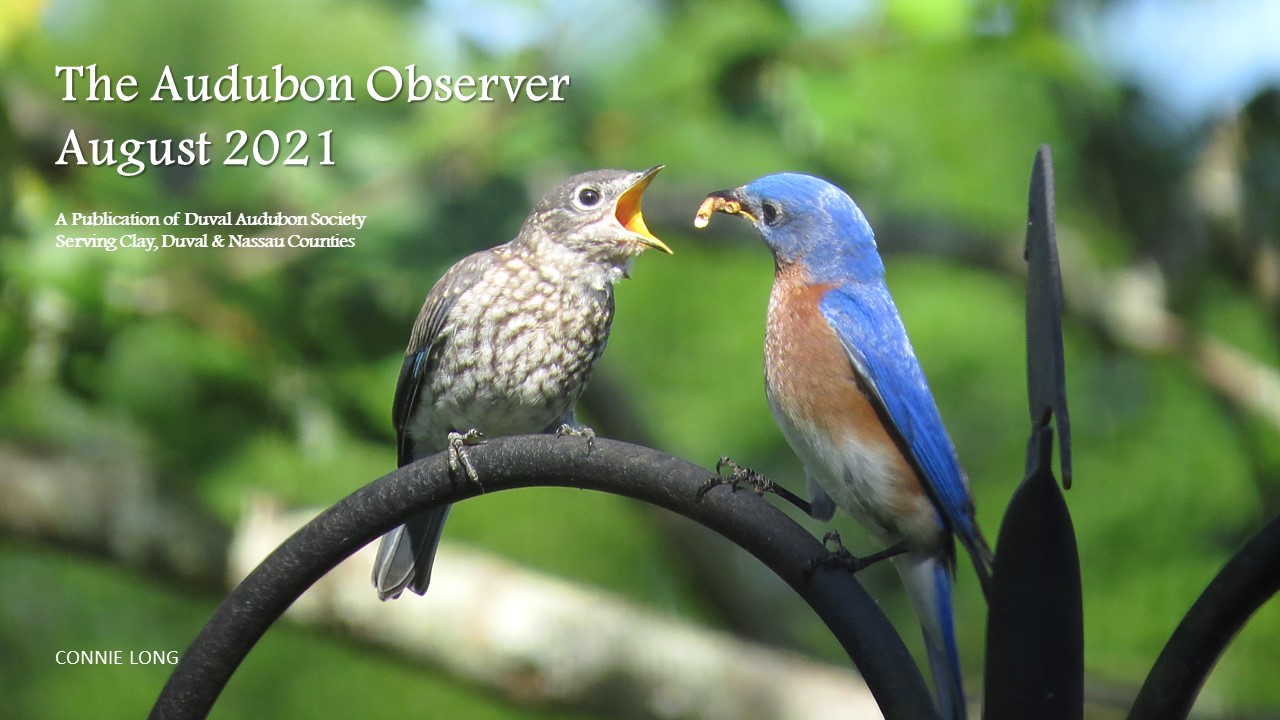



 Lights Out Northeast Florida
Lights Out Northeast Florida In summary, the volunteers found 101 birds that had struck buildings; 71 were dead and 30 were stunned. Most of the stunned birds recovered and were taken to points north of town so that they would not have to pass through downtown again!
In summary, the volunteers found 101 birds that had struck buildings; 71 were dead and 30 were stunned. Most of the stunned birds recovered and were taken to points north of town so that they would not have to pass through downtown again!  Last weekend a small crew worked at
Last weekend a small crew worked at  How were these highly invasive plants removed, you might ask? Well, if you read the guidance from
How were these highly invasive plants removed, you might ask? Well, if you read the guidance from  The other control method was chemical control by careful application of herbicides to the target invasive plants only. Two herbicides were applied using frill and girdle, cut stump and foliar applications (spraying leaves). Garlon 3a herbicide was applied to woody trees such as camphor and tallow in a girdle cut at the base of the tree (larger trees) and to cut stumps (smaller trees). Rodeo herbicide was applied by foliar application to herbaceous species such as Japanese climbing fern, air potato, and Johnsongrass. Some may question the use of herbicides, but they are absolutely necessary in the fight against invasive species. That said, common sense tells you not to overdo it with the herbicide. When used sparingly and targeted to the invasive plants only, then herbicides can be used effectively and safely within natural areas and preserves. It’s when they are applied in excess or over too large an area at one time, such as farms or aquatic weed infestation areas, that they can become a real problem.
The other control method was chemical control by careful application of herbicides to the target invasive plants only. Two herbicides were applied using frill and girdle, cut stump and foliar applications (spraying leaves). Garlon 3a herbicide was applied to woody trees such as camphor and tallow in a girdle cut at the base of the tree (larger trees) and to cut stumps (smaller trees). Rodeo herbicide was applied by foliar application to herbaceous species such as Japanese climbing fern, air potato, and Johnsongrass. Some may question the use of herbicides, but they are absolutely necessary in the fight against invasive species. That said, common sense tells you not to overdo it with the herbicide. When used sparingly and targeted to the invasive plants only, then herbicides can be used effectively and safely within natural areas and preserves. It’s when they are applied in excess or over too large an area at one time, such as farms or aquatic weed infestation areas, that they can become a real problem.
